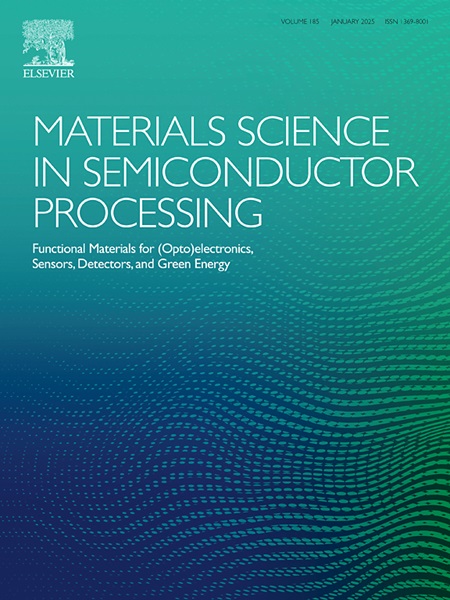Electronically tunable Z-scheme GaS/AlSb heterojunction and its optical properties
IF 4.6
3区 工程技术
Q2 ENGINEERING, ELECTRICAL & ELECTRONIC
引用次数: 0
Abstract
This work investigates the geometric structure, electronic and optical properties of the GaS/AlSb van der Waals heterojunction (vdwH) using first-principles density functional theory (DFT) calculations. The investigation reveals that the pristine GaS/AlSb heterojunction, featuring a 3.40 Å interlayer distance, exhibits the utmost structural stability. Furthermore, this junction displays a narrowed band gap in comparison to its constituent monolayers, thereby facilitating the efficient generation and excitation of photogenerated carriers. The heterojunction belongs to the Z-scheme heterojunction in Type-II, which is more conducive to the enhancement of the redox capability of the heterostructure. The GaS/AlSb heterojunction has a higher Ultraviolet Rays (UV) absorption coefficient, which is valuable for applications in the field of UV photodetectors. Upon the application of both an electric field and strain to the GaS/AlSb van der Waals heterostructure (vdwH), it is found the band gap size of the heterojunction, and the direction of electron transfer can be effectively regulated. The light absorption coefficient and absorption range of heterojunctions can be improved to some extent by applying external strains, which can effectively improve the optical performance of the heterojunction. This study can provide a theoretical basis for the application of GaS/AlSb vdwH in future optoelectronic devices.
电子可调谐 Z 型 GaS/AlSb 异质结及其光学特性
这项研究利用第一原理密度泛函理论(DFT)计算方法研究了 GaS/AlSb 范德华异质结(vdwH)的几何结构、电子和光学特性。研究发现,原始 GaS/AlSb 异质结的层间距离为 3.40 Å,具有极高的结构稳定性。此外,与组成它的单层相比,这个结的带隙变窄了,从而促进了光生载流子的有效产生和激发。该异质结属于第二类 Z 型异质结,更有利于增强异质结构的氧化还原能力。GaS/AlSb 异质结具有更高的紫外线(UV)吸收系数,在紫外线光电探测器领域具有重要的应用价值。在对 GaS/AlSb 范德瓦尔斯异质结构(vdwH)施加电场和应变后,发现异质结的带隙大小和电子转移方向可以得到有效调节。通过施加外部应变可以在一定程度上改善异质结的光吸收系数和吸收范围,从而有效提高异质结的光学性能。本研究可为 GaS/AlSb vdwH 在未来光电器件中的应用提供理论依据。
本文章由计算机程序翻译,如有差异,请以英文原文为准。
求助全文
约1分钟内获得全文
求助全文
来源期刊

Materials Science in Semiconductor Processing
工程技术-材料科学:综合
CiteScore
8.00
自引率
4.90%
发文量
780
审稿时长
42 days
期刊介绍:
Materials Science in Semiconductor Processing provides a unique forum for the discussion of novel processing, applications and theoretical studies of functional materials and devices for (opto)electronics, sensors, detectors, biotechnology and green energy.
Each issue will aim to provide a snapshot of current insights, new achievements, breakthroughs and future trends in such diverse fields as microelectronics, energy conversion and storage, communications, biotechnology, (photo)catalysis, nano- and thin-film technology, hybrid and composite materials, chemical processing, vapor-phase deposition, device fabrication, and modelling, which are the backbone of advanced semiconductor processing and applications.
Coverage will include: advanced lithography for submicron devices; etching and related topics; ion implantation; damage evolution and related issues; plasma and thermal CVD; rapid thermal processing; advanced metallization and interconnect schemes; thin dielectric layers, oxidation; sol-gel processing; chemical bath and (electro)chemical deposition; compound semiconductor processing; new non-oxide materials and their applications; (macro)molecular and hybrid materials; molecular dynamics, ab-initio methods, Monte Carlo, etc.; new materials and processes for discrete and integrated circuits; magnetic materials and spintronics; heterostructures and quantum devices; engineering of the electrical and optical properties of semiconductors; crystal growth mechanisms; reliability, defect density, intrinsic impurities and defects.
 求助内容:
求助内容: 应助结果提醒方式:
应助结果提醒方式:


